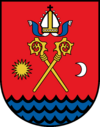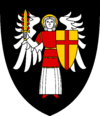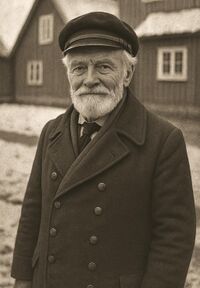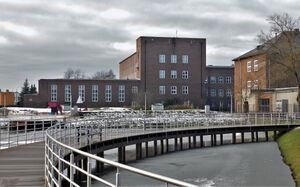Nieski Islands

|
Nieski Islands Wyspy Nieskańskie (Veltic) Capital: Nieski
Population: 28 657 (2025) Motto: Honor i odwaga Anthem: Pieśń wojów |
Loading map... |
Nieski Islands (Veltic: Wyspy Nieskańskie; Sulitsillumkejle: Soadjiagearpmašasullot), is an archipelagic country in the northern part of West Uletha, situated in the Great North Sea, to the east of Silland, north of UL13c and Velticia and west of Ostland.
Nieski Islands is situated in an east part archipelago of the same name, comprises Drakobór, Warnima on which 90% of the population resides and ±2,000 skerries and smaller islands. Nieski Islands has a population of over 28 thousand, and is one of the smallest countries in the world. Its capital is Nieski, only town in the country.
Independent Nieski Islands derives directly from the structures of the Nieski diocese, which is a remnant of the abolished monastic state of Saint Alexandrine. Due to the size of the country and the lack of military structures, Nieski Islands is partially dependent on neighboring countries, their economies and protection.
Etymology
The name Nieski derives directly from the name Niska, which means something low, situated at a low altitude, or of small height. This name first appeared on a map by the cartographer Olgierd of Darbno in the 14th century and referred to a small Veltic whaling settlement, most likely unrelated to the current town of Nieski (archaeological research suggests that the settlement was located on the island of Czysznanica). The settlement of Niska did not play a significant role and likely existed for only a few decades. However, the map on which it was featured became an important element of contemporary science and knowledge about northern islands. The name on the map likely began to be associated with an archipelago north of the islands of Aleksandrynia and Kniań.
The slightly distorted form Nieski (in the plural form) first appeared in a letter to the Bishop of Darbno in 1578 and referred to two human settlements located on what is now the island of Warnima. It is believed that around 1650, the construction of a fort by the Knights of the Order of St. Alexandrine began in the vicinity of these settlements, which is now the present-day city of Nieski. This name has been used since the establishment of the fort.
In 1662, the Diocese of Nieski was established, which in 1710 was transformed into the Principality of Nieski — a precursor to the current state.
History
| History of Nieski Islands | |
|---|---|
| Pre-state period | before 1615 |
| • Sillimi Colonization | before 1344 |
| • Veltic-Glynian Colonization | 1344-1615 |
| • Religious wars | 1615-1630 |
| Ecclesiastical states | 1630-1810 |
| • The State of the Order of Saint Alexandrine | 1630-1710 |
| • Principality of Nieski | 1710-1810 |
| Republican Era | 1810-present |
| • Republic of Nieski | 1810-1940 |
| • Veltic occupation | 1812-1935 |
| • Nieski Islands | 1940-present |
Pre-state period
Ecclesiastical states
Republican Era
1935-1940: Reform of the state after the end of the Veltic occupation
The withdrawal of Veltic troops from the Nieski Islands caused concern among the majority of the islands' inhabitants. There were fears of a potential breach of the peace treaty by Jemias and, due to the distance, a lack of quick intervention capability by Velticia, which, by virtue of the treaty, had become the guarantor of the Nieski Islands' security. The long-standing wars and the granting of civil rights to the Sillimi population also contributed to the emergence of xenophobic attitudes among the Veltic residents of the islands, resulting in fears for the safety of the Sillimi people.
A positive role in improving neighborly relations was played by the then Head of State, Walery Lissański. Hailing from Lissa (a settlement predominantly inhabited by the Sillimi), Lissański was well-versed in the local language and held in high regard by the local population. Prior to the granting of civil rights to the Sillimi, Lissański was considered an ambassador for their cause in the capital. Following the departure of Veltic forces from the islands, he endeavored to build positive diplomatic relations with the government of Jemias, making two visits to their capital. During the People's Assembly in 1935, Lissański publicly declared the initiation of a five-year period for the adjustment of Nieski law to the terms of the peace treaty, including the full and equal integration of the Sillimi population into the public life of the state.
Another issue arising from the departure of Veltic troops from the islands was a brief food and economic crisis. The military presence had facilitated trade between the islands and the continent, benefiting the inhabitants of the Republic of Nieski. The disruption of these long-standing supply chains adversely affected the Nieski economy, particularly by dangerously interrupting the food supply chain. Within two years, the Nieski government managed to stabilize the situation by increasing the state's food self-sufficiency (which had previously been minimal) and by entering into new trade agreements with countries in the Great North Sea basin. However, challenges remained, including significant increases in food prices, rising inflation, and public debt.
In 1936, a new administrative unit known as the Lissa District was established, carved out from parts of the Lugidynia District and islands that had previously been outside any local government jurisdiction. The seat of the Lissa District’s administration was located in Lissa. The creation of this new territorial unit was part of the implementation of the requirements imposed on the Republic of Nieski by the peace treaty. The Lissa District was predominantly inhabited by the Sillimi people, who constituted 83% of the population. It had the same level of self-governance as other districts, with the distinguishing feature of full bilingualism. In the same year, the authorities of the newly formed district, along with those of other districts and the city of Nieski, began issuing identity cards to residents of Sillimi origin.
The introduction of equal rights for the Sillimi population renewed the debate on granting electoral rights to women. Until June 1936, women, regardless of their origin, were prohibited from running for public office or participating in the People's Assembly. In response to this situation, a small-scale feminist demonstration was held in Nieski in June 1936. Although the event was modest in scale, it resonated widely within the conservative Nieski society and prompted the government to consider expanding the state reform to modernize the archaic system of governance on the islands.
The main proponent of the changes was Marcin Karczyński, Head of the Department of Internal Affairs, who proposed the adoption of a new constitution modeled on the fundamental laws of Southern Uletha countries. Karczyński advocated not only for granting women both passive and active electoral rights but also for the establishment of a parliament, shifting the system from direct democracy to a representative system. His proposals were endorsed by Walery Lissański, although conservative members of the ruling elite described them as a threat to democracy and Nieski tradition. During the People's Assembly in 1937, a Constitutional Commission was established with the goal of drafting a new constitution for the state. The commission included representatives from the government, the city of Nieski, all districts, and settlement units. Legal experts and foreign observers from Velticia and Jemias were also invited to participate in the process.
The draft constitution, known as the Law (Prawo), was publicly presented in the spring of 1938. The document encompassed the main demands of the liberal faction, including the principle of equal treatment regardless of nationality, gender, or religion. The constitution proposed the establishment of a unicameral parliament and the office of the president at the head of the government. It also included a proposal to change the name of the state from the Republic of Nieski to the Nieski Islands, which was explained as a matter of marketing. The most significant controversy arose from the proposal to abolish the People's Assembly. However, proponents of the new law assured that the system of direct democracy would still be maintained at the local level. After minor adjustments, the draft constitution was reintroduced at the People's Assembly in 1939, where it received majority approval. The new constitution was scheduled to come into effect in May 1940, following the first parliamentary and presidential elections in the state's history.
Government and politics
| Government of Nieski Islands | |
|---|---|
| Unitary presidential constitutional republic | |
| Capital | Nieski |
| Head of state | |
| • President of the Nieski Islands | Aleksandryna Bielińska |
| Legislature | Nieskian Assembly |
| Judiciary | Common Court Court of Appeal Supreme Court |
The political system of Nieski Islands is based on a constitution that has been in effect since May 1, 1940. It is a state with a presidential system, in which the legislative and executive powers are clearly separated. The country does not have formal political parties, which affects the organization and participation of citizens in public life.
Legislative power is exercised by a unicameral parliament, the Nieskian Assembly, consisting of 20 members elected from single-member districts for a five-year term. Executive power is concentrated in the hands of the president, who also serves as the head of government. The president is elected in direct elections for an eight-year term, with the possibility of seeking re-election.
The judiciary in Nieski Islands comprises the Common Court, the Court of Appeals, and the Supreme Court, which handle civil, criminal, and administrative cases within the framework of the applicable law.
Executive Power - President of the Nieski Islands and the State Council
The executive power in the Nieski Islands is organized around the President of the Nieski Islands (Prezydent Wysp Nieskańskich), who stands at the head of the State Council (Rada Państwa). The President is elected for a term of eight years and may run for re-election after the first term. The age requirement for presidential candidates is 35 years. The President has a range of powers, which include managing domestic and foreign policy and representing the country on the international stage. As part of these competencies, the President makes decisions regarding the functioning of the government, including appointing and dismissing heads of departments (with the approval of the majority of the Nieskian Assembly). The State Council supports the President in implementing government policy by analyzing social and economic needs and formulating appropriate recommendations.
The State Council, acting as an advisory body to the President, plays a key role in monitoring the President's actions, ensuring that his decisions align with the interests of society. The responsibility of the departments for various aspects of public life allows the President to undertake coordinated actions in social, economic, and international policy. The State Council consists of the heads of departments: the Department of Internal Affairs, responsible for internal security, public administration, and crisis management; the Department of Foreign Affairs, dealing with foreign policy, diplomacy, and international relations; the Department of Economy and Development, focusing on economic development, trade, investments, and support for local enterprises; the Department of Health, responsible for public health protection, healthcare systems, and health programs; and the Department of Education and Culture, dealing with the education system, curricula, and support for culture and local initiatives.
The President has the right of legislative initiative, meaning he can propose new laws or amendments to existing ones. Presidential proposals must be considered by the Nieskian Assembly. The President also has the power of veto, which he can apply to resolutions of the Nieskian Assembly, which in turn can override the veto with a qualified majority of votes (2/3 of the full composition).
In the event of a violation of the law, treason, or the commission of other serious crimes by the President, it is possible to initiate impeachment proceedings. The initiative in this matter belongs to the Nieskian Assembly, which decides to refer the case to the Supreme Court. Specific grounds are required to initiate the proceedings.
In the case of a vacancy in the office of the President, for example, due to his removal, death, or resignation, the succession procedure is clearly defined. In the first instance, the duties of the President are taken over by the head of the department designated by the outgoing President; subsequently, succession occurs according to the age of the heads of departments (the duties of the President are assumed by the oldest person). This mechanism ensures a smooth transition of power and administrative stability. The designated head of department serves as the acting President until the new President is sworn in.
The residence of the President of the Nieski Islands is the Bieliński Palace in Nieski.
Legislative Power - Nieskian Assembly
The legislative power in Nieski Islands is represented by the Nieskian Assembly, which plays a crucial role in the law-making process. This parliament consists of 20 members elected in single-member electoral districts for a five-year term. The age requirement for candidates to the Nieskian Assembly is 25 years. The Constitution of Nieski Islands does not provide for the existence of political parties or formal factions in the parliament, which promotes the independence of members and direct citizen engagement in legislative processes.
The Nieskian Assembly plays a key role in the legislative process. Its responsibilities include passing new laws and amending existing legal provisions. Members of the Assembly have the right to legislative initiative, meaning they can propose new draft laws, which are then considered by the entire Assembly. The legislative process also includes debates and votes, which are essential for the adoption of laws. Once a law is passed, it is sent to the President of Nieski Islands, who has the option to exercise the veto power. The Nieskian Assembly also has the ability to override the President's veto, requiring a qualified majority of votes (2/3 of the votes).
The Nieskian Assembly has the authority to make changes to the state budget, influencing the allocation of public funds. Reviewing and approving the budget are key aspects of the Assembly's activities, which aim to ensure the balanced economic development of the country. The Assembly also has oversight powers over the executive branch. Members have the right to ask questions and submit inquiries regarding the actions of the President and department heads. This oversight is intended to ensure transparency and accountability in the operations of government bodies.
The Assembly meets regularly, and its sessions are public, allowing citizens and the media to have insight into legislative processes. The transparency of the proceedings is essential for maintaining public trust and ensuring that the decisions made by the Assembly reflect the will of the residents of Nieski Islands.
List of Heads of State
Prince-Bishops of Nieski (1710-1810)
- 1710–1725 - Michał Wołcza
- 1725–1732 - Jaromir Lubomir Miednicy
- 1732–1749 - Kazimierz Łęczyna
- 1749–1750 - Gerrit van der Zandenbosch
- 1750–1761 - Radogost Ogrodzieniec
- 1761–1777 - Dobromir Zarancki
- 1777–1781 - Adam Branicz
- 1781–1785 - Żegota Tarnowicz
- 1785–1810 - Leon Vettarini del Valle
Chiefs of the Nieski Republic (1810-1940)
- 1810-1812 - Gabriel Siemiński
- 1812-1820 - Klemens Bogusławski
- 1820-1828 - Eligiusz Wilford
- 1828-1832 - Stanisław Bieliński starszy
- 1832-1852 - Stanisław Bieliński młodszy
- 1852-1867 - Florian Lissański
- 1867-1876 - Romuald Sułła
- 1876-1878 - Aleksander Horynicki
- 1878-1899 - Feliks Czarnikiewicz
- 1899-1905 - Wojciech Mokrogórski
- 1905-1917 - Leopold Krummholz
- 1917-1921 - Wojciech Mokrogórski
- 1921-1940 - Walery Lissański
Presidents od the Nieski Islands (1940-)
- 1940-1942 - Walery Lissański (elected in 1940, resigned)
1942 - Jakub Kołodziej (acting president) - 1942-1950 - Marcin Karczyński (elected in 1942)
- 1950-1966 - Igor Jaroszowski (elected in 1950 and 1958)
- 1966-1979 - Stanisław Kłobucznicki (elected in 1966 and 1974, died while in office)
1979 - Siemowit Wareński (acting president) - 1979-1995 - Emil Buż (elected in 1979 and 1987)
- 1995-2003 - Maryna Läkje (elected in 1995)
- 2003-2019 - Borzywoj Kłobucznicki (elected in 2003 and 2011)
- 2019-incumbent - Aleksandryna Bielińska (elected in 2019)
Administrative divisions
| Administrative unit | Administrative seat | Population | ||
|---|---|---|---|---|
| Coat of Arms | Name | Population Count | % of Population | |
| City (Gród): | ||||

|
City of Nieski∈⊾ƨ Gród Nieski |
- | 15 761 | 55.0% |
| Districts (Cyrkuły): | ||||

|
Aleksandrynia District∈⊾ƨ Cyrkuł aleksandryński |
Aleksandrynia Nieskańska | 1 976 | 6.9% |
| CoA | Lissa District Cyrkuł lissański |
Lissa | 2 913 | 10.2% |
| CoA | Lugidynia District Cyrkuł lugidyński |
Lugidynia | 3 184 | 11.1% |
| CoA | Warnima District Cyrkuł warnimski |
Nieski | 4 823 | 16.8% |
Geography
The Nieski Islands are located in the western part of the Great North Sea, to the east of Silland, north of UL13c and Velticia and west of Sapvuodma. They consist of a cluster of over ±2,000 islands and skerries, but only around dozen of them are inhabited.
The surface of the islands is generally rocky, with red and pink granite peppered with quartz crystals predominating. The soil is thin, stripped away by retreating glaciers at the end of the most recent ice age. The islands' topography varies significantly from one landmass to another. While some islands are relatively flat and feature fertile plains, others have more undulating terrain with elevated ridges and small hills. Due to its coastal location, the Nieski Islands boast an intricate network of fjords, inlets, and sheltered bays, contributing to the overall complexity of their topography. The coastlines are jagged and indented.
The highest elevation of the Nieski Islands is Mount Kostuch located on the island of Holsztuna, reaching an altitude of approximately 112 meters above sea level.
Economy
Distilling
One of the pillars of the country’s economy is high-proof alcohol. The lack of fertile soil and the short growing season have led the local population to specialize, over generations, in distilling alcohol from wild herbs, roots, and marshland raw materials — using local fermentation techniques and peat smoking. Nieski spirits are known for their unique sensory profile: intensely herbal, bitter, with a distinct note of peat and ash. Some of these products are recognized beyond the country’s borders, considered prestigious beverages and an important symbol of national cultural identity.
The most prestigious and internationally recognized distillery in the archipelago is C.A. Angowski, located in Ostoja na Warnimie. This distillery was founded in the 19th century by a physician and herbalist, Cibor Angowski. The company gained fame for producing a bitter, root-and-herb liqueur called Śmierć Mnicha (Death of the Monk), which remains one of the country’s main export products and a hallmark of the Nieski alcohol industry. Cibor Angowski, founder of the distillery, was a declared atheist and anti-clericalist, which stirred opposition and controversy in the deeply religious society of the archipelago. For this reason, his products were initially unpopular locally. Angowski therefore turned to export markets, where the liqueur quickly gained recognition.
One of the key pillars of the distillation industry is the Sułła — the largest distillery in the country-located in the city of Nieski. Sułła is responsible for over 40% of the nation’s alcohol production and specializes in scalable, standardized versions of local spirits. The company’s portfolio includes various types of vodka and herbal extracts used in the pharmaceutical and food industries.
In total, there are around 20 distilleries operating across the Nieski Islands. Alcoholic products made on the archipelago are protected under a geographical indication system as regional origin goods, and some of them have been granted intangible heritage status in the national registry of traditions.
Agriculture
Agriculture on the Nieski Islands is severely limited by the harsh subarctic climate, characterized by long, cold winters and a short, cool growing season. Additionally, the unfavourable geological structure features predominately crystalline bedrock, a thin soil layer, and low soil fertility. These conditions significantly constrain agricultural potential.
Crop production focuses on plant species that are tolerant of low temperatures and capable of rapid maturation, such as barley, rye, turnips, rutabagas, and potatoes. Farms are typically small-scale and local in nature, often relying on extensive farming methods. Animal husbandry also plays a significant role, with a focus on livestock well adapted to cold climates-primarily sheep, goats, and reindeer.
Due to the challenging natural conditions, agriculture is unable to fully meet the nutritional needs of the population. As a result, the Nieski Islands rely heavily on the import of food and other essential goods. Complementing local agricultural efforts are traditional economic sectors such as fishing and forestry, which continue to serve as important sources of raw materials and employment.
Communication
Aviation
The first airport on the territory of the present Nieski Islands was built in the 1930s, to the east of the city of Nieski. It was constructed by the military forces of Velticia as a logistics base and supply point during the ongoing conflict with Jemias. Construction began in 1930, and the facility was opened in 1932, although it remained a temporary structure throughout its operational period. The main runway, made of compacted earth and gravel, was approximately 950 meters long. The infrastructure included wooden barracks used as warehouses, technical quarters, and a command center. Nearby were temporary fuel depots, anti-aircraft positions, and earth fortifications. The airport was not equipped with radio navigation or runway lighting, which limited operations to daylight hours and favorable weather conditions.
After the Velticia forces left the archipelago in 1935, the airport was partially abandoned and occasionally used by local authorities. Most of the buildings deteriorated over time or were dismantled. In the 1950s, discussions began about reopening the Nieski airport, this time for civilian use. Initial modernization efforts began in the 1960s, and by the end of the decade, the facility was officially opened as Nieski Airport. The opening was conducted by President Stanisław Kłobucznicki. Initially, the partially gravel runway was still in use, but it was soon paved due to increasing traffic and the technical requirements of new aircraft.
In the following decades, the airport's infrastructure was gradually modernized. In the 1980s, the original, small terminal building was replaced with the current one. The apron was expanded, technical facilities were developed, and basic radio navigation systems were introduced. Further modernization continued in the following years, adapting the airport to changing standards and the needs of regional traffic.
Nieski Airport has a 2503-meter long concrete runway, with the designation 14/32, indicating the runway direction – 14° to the southwest and 32° to the northeast. Parallel to the main runway, there is also a short grass runway used by the local aero club for sport aviation. The construction of the airport required the crossing of the road between Nieski and Wetoszyn, which led to the need for a new road to be built around the airport's perimeter.
Buses
Bus transport on the Nieski Islands is the most popular form of public land transport. The system is operated mainly by Towarzystwo Przewozowe (TP) and includes both urban services in the city of Nieski and regular routes linking the city with rural areas on the islands. TP maintains a standardized bus fleet and fare schemes integrating bus and ferry services.
The first regular bus line on the archipelago was established in 1926 at the initiative of Dobromir Arcymowicz, a retired soldier of the Veltic Northern Corps. The bus — a converted military truck — connected Nieski with settlements on Warnima Island, giving rise to the Arcymowicz company. In 1931 the enterprise obtained permission to operate regular lines on Drakobór Island and in practice faced no competition. After Arcymowicz’s death in 1938, the company was taken over by his daughter, Felicja Etrycka. In 1941, after the withdrawal of Veltic troops, the firm found itself in financial difficulty. Etrycka carried out a restructuring that included a merger with the largest ferry operator, Link Star, together with other smaller transport businesses, creating Towarzystwo Przewozowe.
Despite its monopoly in the 1950s, a severe socio-economic crisis threatened TP with collapse, prompting the government of the Nieski Islands in 1958 to purchase and nationalize the enterprise, transforming it into Powszechne Towarzystwo Przewozowe (PTP). The 1960s and 1970s were marked by the gradual rebuilding of the role of public transport on the archipelago. In 1984 the company was commercialized as a limited liability company while remaining state-owned. In 1996 it underwent a rebranding: the historical name Towarzystwo Przewozowe was restored, along with the traditional logo — the rotated star —and the fleet’s visual identity was unified.
Towarzystwo Przewozowe currently performs about 95% of bus transport on the archipelago, remaining the de facto monopolist in public land transport. The few private services are limited to occasional operations. TP’s fleet is being systematically modernized—around 80% of vehicles are hybrid buses, and further growth in the share of low-emission vehicles is planned. The company’s headquarters are located at Przystań Aleksandyńska in Nieski; the main operational base is the depot in Bożywojówka, opened in the 1980s.






